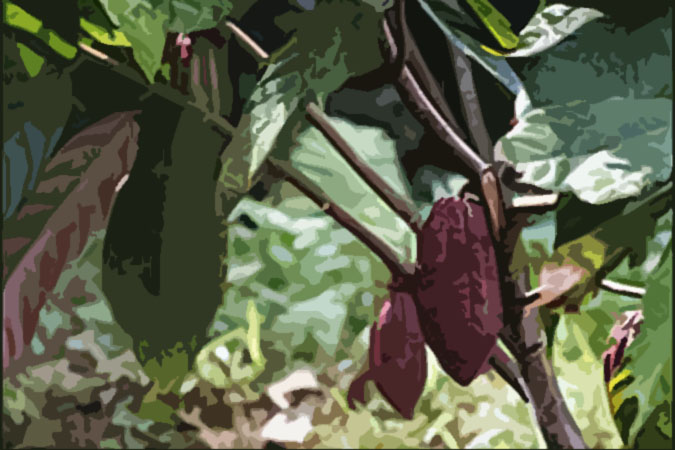Who knew such a luscious flavor would also be a stimulating food? Ancient peoples of the Americas did.
Cacao, cocoa, and chocolate are different terms, but all come from the same tree. The word cocoa is an Anglicized version of cacao, and the word “chocolate” has roots in native languages of the Americas.
What is chocolate? Chocolate is obtained from the cacao tree, a tropical evergreen known as Theobroma cacao (which translates from Greek as “food of the gods”). Each large cacao pod yields about 40 seeds or “beans” which are fermented, dried, and roasted. They’re then processed into cocoa solids, non-alcoholic cocoa liquor (a mix of solids and fat), and cocoa butter, the essential ingredients in chocolate products. Cocoa butter is the fat, with no caffeine or other stimulants. Cocoa liquor and solids are processed into eating chocolates and cocoa powders, sometimes with cocoa butter added back in.
What are the typical types of eating chocolate? Solid chocolate is basically finely ground cocoa solids suspended in cocoa butter. The more solids, the darker the chocolate, and the more stimulants contained. Milk chocolate includes milk and sugar, with less cocoa liquor or solids. White chocolate isn’t true chocolate; it contains cocoa butter and no cocoa solids or liquor.
Many dark chocolate bars promote the high percentage of cacao on their label, as in 72% chocolate (the combined weight of the cocoa solids and cocoa butter; the rest is usually sugar). Mass market chocolates often contain almost no real cacao, as little as 10% chocolate liquor which is the minimum required by U.S. regulations.
Cocoa powder is dried cocoa liquor, ground and unsweetened, and used in cooking and beverages. Instant cocoa powder has sugar added. Unsweetened chocolate is mainly for baking and cooking, and is known as bitter, baking, or unsweetened chocolate. Semi-sweet or bittersweet chocolate contains a high percentage of cocoa liquor and solids, and some sugar. Cocoa nibs, or cacao nibs, are the crunchy inner bits of roasted cocoa beans, and are added to recipes for texture and flavor.
Where does chocolate come from? Cacao trees are native to tropical rainforests in South and Central America, but now grow in equatorial zones around the globe. West Africa produces 70% of the world’s cacao, led by Ivory Coast, and followed by Ghana, Nigeria, and Cameroon. Indonesia is the world’s second-largest producing country. Producers in the Americas include Brazil, Ecuador, Dominican Republic, Colombia and Mexico.
How much caffeine does chocolate contain? A 1-ounce portion of chocolate averages about 20 mg of caffeine and 130 mg of theobromine; the combined effect is similar to that of a cup of tea with 40 mg of caffeine. Why? Chocolate contains a small amount of caffeine, and seven to ten times more theobromine than caffeine. Caffeine is the more potent of the two stimulants, but theobromine’s greater quantity makes it the predominant buzz in chocolate. Together they pack a punch: the combined impact of caffeine and theobromine in chocolate is roughly twice that of caffeine alone. (Theobromine also occurs in small amounts in tea, guarana, mate, and kola nut; and when caffeine is metabolized by the liver, it releases theobromine as a byproduct.)
What else does chocolate contain? Some people say they’re addicted to chocolate, and there may be some truth to that. Chocolate sparks several feel-good chemicals in the brain. Anandamide is a mood-altering substance in chocolate, and also occurs naturally in the brain. It’s related to THC, the psychoactive compound in marijuana. Chocolate causes the brain to release the neurotransmitter phenylethylamine (PEA), known as the love-drug because it’s released when we fall in love. Chocolate has a small amount of tryptophan, which stimulates serotonin, and in high quantities promotes good feelings. Flavenoids and antioxidants in chocolate have been linked to cardiovascular health benefits.

